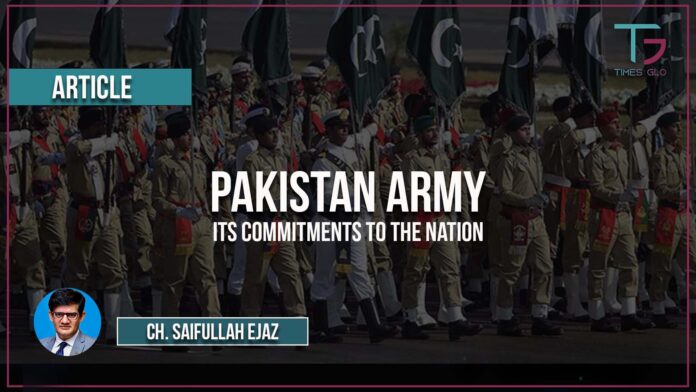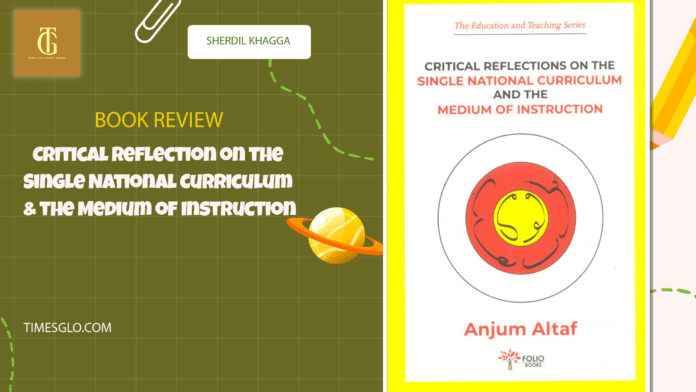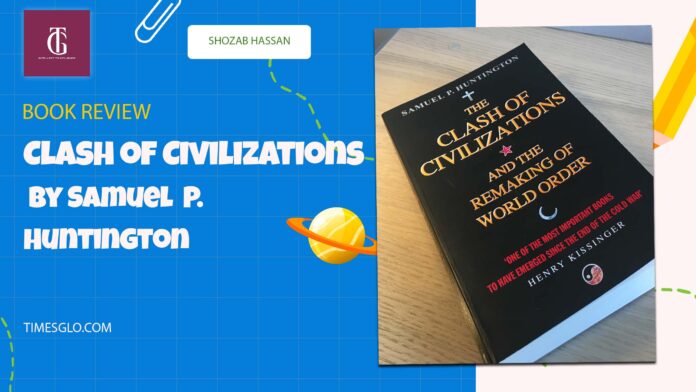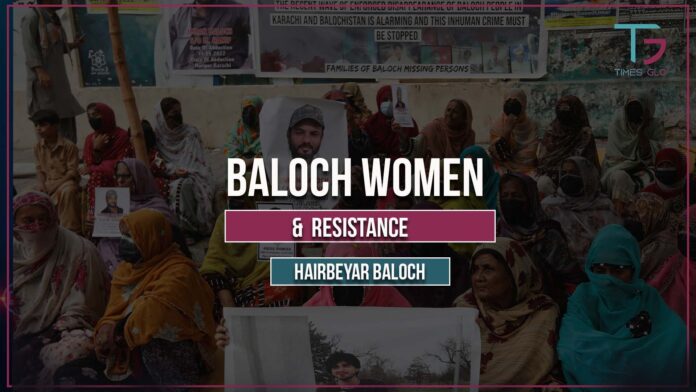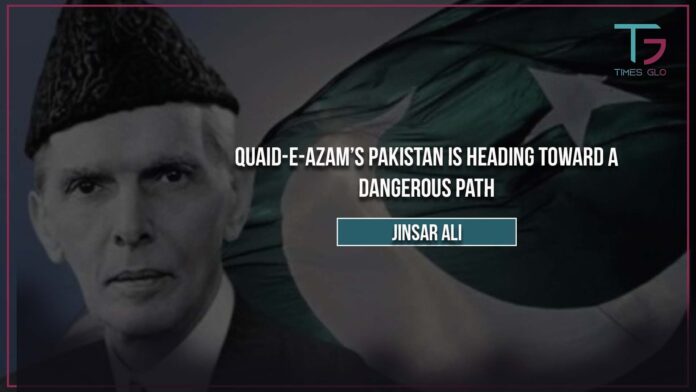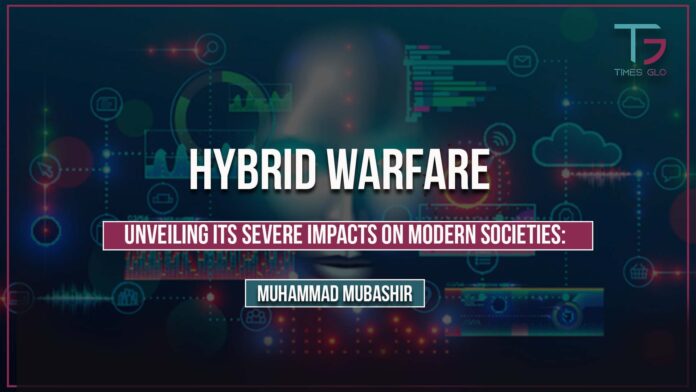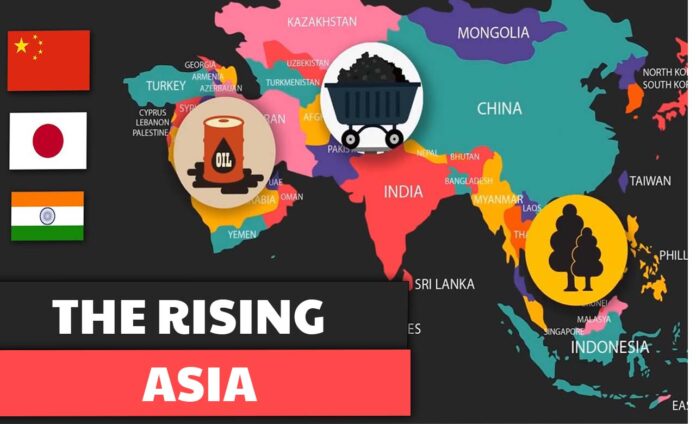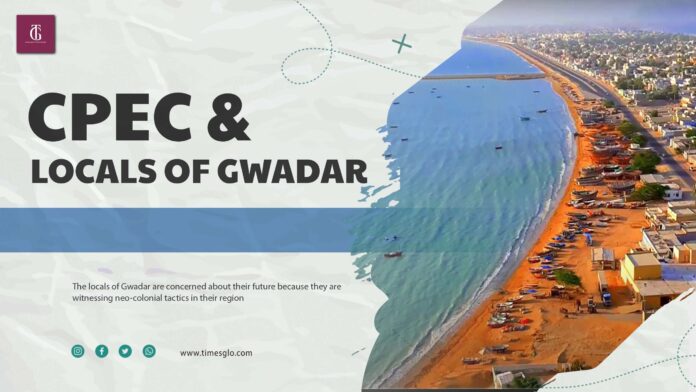Pakistan Army is the land-based branch of the Pakistan Armed Forces. It plays a significant role in ensuring the security and defense of Pakistan. The army’s commitment to the nation can be understood through several key aspects but not limited to the national defense, Internal Security, Disaster relief and humanitarian assistance, Nation building, Peacekeeping missions.
National Defense
The primary responsibility of the Pakistani Army is to safeguard the territorial integrity and sovereignty of Pakistan. It is committed to protecting the nation from external threats and maintaining peace and stability within its borders. It is pertinent to mention that National defense in Pakistan is a critical aspect that ensures the protection of the country’s territorial integrity, sovereignty, and national interests.
The Pakistani Army, as the land-based branch of the Pakistan Armed Forces, plays a central role in national defense. In General, the Pakistani Army is dedicated to the national defense of Pakistan and works closely with other branches of the Pakistan Armed Forces, as well as civilian institutions, to safeguard the country’s interests and ensure its security.
Here are some key points regarding national defense in Pakistan and the role of the Pakistani Army.
Threat Perception: Pakistan faces various security challenges, including external threats and internal security concerns. The country shares borders with India, Afghanistan, Iran, and China, and the Pakistani Army is responsible for countering potential threats and ensuring the defense of the nation.
Defense Strategy: Pakistan’s defense strategy focuses on maintaining a credible deterrence capability. The Pakistani Army, along with the Pakistan Air Force and Pakistan Navy, works together to develop and implement this strategy. It involves a combination of conventional and unconventional warfare capabilities, including a strong conventional military force, a robust nuclear deterrence, and counterinsurgency measures.
Conventional Warfare: The Pakistani Army maintains a well-trained and equipped conventional force to protect the country against external aggression. It has a diverse range of land-based capabilities, including armored divisions, artillery, infantry, and other specialized units. The army conducts regular training exercises, develops doctrines, and acquires modern military technology to enhance its combat effectiveness.
Nuclear Deterrence: Pakistan possesses a nuclear arsenal, and the Pakistani Army plays a crucial role in safeguarding and maintaining this deterrent capability. The army is responsible for the security, safety, and control of Pakistan’s nuclear weapons. It ensures that these weapons are only used as a deterrent against any potential aggression, thereby ensuring the country’s security.
Border Security: The Pakistani Army is actively involved in securing the borders of Pakistan. It conducts border patrols, establishes border posts, and monitors any suspicious activities along the borders. The army works closely with other law enforcement agencies to prevent cross-border infiltration, smuggling, and other illegal activities.
Internal Security Operations: In addition to external defense, the Pakistani Army is engaged in internal security operations to counter terrorism, insurgency, and maintain law and order. It assists civilian law enforcement agencies in conducting operations against extremist groups and ensuring the safety of Pakistani citizens.
Regional and International Cooperation: The Pakistani Army engages in regional and international military cooperation to enhance its defense capabilities and contribute to regional stability. It participates in joint military exercises, exchanges military delegations, and cooperates with other countries on defense matters.
Internal Security
In addition to external defense, the Pakistani Army is actively involved in maintaining internal security. It assists civilian law enforcement agencies in combating terrorism, insurgencies, and other security challenges within the country. This commitment is crucial in ensuring the safety of Pakistani citizens and the stability of the nation. As internal security is a crucial aspect for any nation, and the Pakistani Army plays a significant role in maintaining internal security within Pakistan.
It is important to note that while the Pakistani Army plays a crucial and significant role in maintaining internal security, it operates within the framework of the law and under the overall control and guidance of the civilian government. The army’s actions are aimed at protecting the welfare of Pakistani citizens and ensuring peace and stability within the country.
Here are some key points regarding internal security and the role of the Pakistani Army.
Counter terrorism Operations: Pakistan has faced significant challenges related to terrorism and extremism. The Pakistani Army has been actively involved in conducting counterterrorism operations across the country. It works in close coordination with other law enforcement agencies, such as the police and paramilitary forces, to neutralize terrorist networks, dismantle their infrastructure, and ensure the safety of Pakistani citizens.
Border Security: The Pakistani Army is responsible for securing the borders of Pakistan, which is vital for maintaining internal security. It conducts border patrols, establishes checkpoints, and employs surveillance measures to prevent cross-border infiltration, smuggling, and other illegal activities that may pose threats to internal security.
Support to Civilian Law Enforcement: The Pakistani Army provides support to civilian law enforcement agencies in maintaining law and order in various situations. This assistance may include assisting the police in controlling riots, maintaining public order during emergencies, and providing backup in high-risk operations.
Intelligence and Surveillance: The Pakistani Army contributes to intelligence gathering efforts to identify potential security threats within the country. It works closely with intelligence agencies to collect and analyze information, monitor suspicious activities, and take preemptive measures to counter any potential threats to internal security.
Rehabilitation and Reconstruction: The Pakistani Army is involved in post-conflict rehabilitation and reconstruction efforts. After successfully conducting military operations in conflict-affected areas, the army participates in rebuilding infrastructure, providing humanitarian assistance, and facilitating the return of displaced persons. This helps restore normalcy and improve the overall security situation.
Training and Capacity Building: The Pakistani Army plays a vital role in training and capacity building of civilian law enforcement agencies. It conducts training programs for police forces, paramilitary units, and other security agencies to enhance their capabilities in countering internal security threats effectively.
Crisis Response and Disaster Management: The Pakistani Army has a strong commitment to crisis response and disaster management. It actively participates in rescue and relief operations during natural disasters, such as earthquakes, floods, and avalanches. The army’s quick response, deployment of resources, and coordination with civil authorities contribute significantly to mitigating the impact of such disasters and maintaining internal security.
Disaster Relief and Humanitarian Assistance
Pakistani Army has a strong commitment to providing relief and assistance during natural disasters and humanitarian crises. It has played a vital role in rescue operations, providing medical aid, distributing food and supplies, and rebuilding infrastructure in the aftermath of earthquakes, floods, and other calamities.
The army’s prompt response and relief efforts demonstrate its commitment to the welfare of the Pakistani people. Its involvement in disaster management and humanitarian operations is a significant aspect of its responsibilities towards the nation. The Pakistani Army’s commitment to disaster relief and humanitarian assistance reflects its dedication to the well-being and safety of the Pakistani people. Its swift response, logistical capabilities, and expertise in crisis management contribute significantly to alleviating suffering and restoring normalcy in disaster-affected areas.
Here are some key points regarding the Pakistani Army’s contributions in disaster relief and humanitarian assistances.
Prompt Response: The Pakistani Army is known for its prompt response in the aftermath of natural disasters. Whether it is earthquakes, floods, avalanches, or other calamities, the army mobilizes quickly to provide immediate relief and assistance to affected areas.
Search and Rescue Operations: The army actively engages in search and rescue operations to locate and save individuals trapped or stranded in disaster-stricken areas. It deploys specialized teams, equipment, and resources to conduct rescue missions, often working in coordination with other national and international relief agencies.
Medical Aid and Field Hospitals: The army sets up field hospitals and medical camps in disaster-affected areas to provide essential medical aid and healthcare services to those in need. This includes emergency medical treatment, surgeries, vaccination campaigns, and disease control measures to prevent outbreaks in the aftermath of disasters.
Distribution of Food and Supplies: The Pakistani Army plays a vital role in distributing food, water, and essential supplies to affected communities. It ensures that affected populations have access to basic necessities and provisions, especially in remote and inaccessible areas where relief efforts may face logistical challenges.
Temporary Shelter and Rehabilitation: The army assists in providing temporary shelter and rehabilitation facilities for displaced individuals and families. It sets up tent cities, establishes temporary settlements, and contributes to the construction of transitional housing to ensure the well-being and safety of those affected by disasters. Reconstruction and Infrastructure Development: Following major disasters, the Pakistani Army actively participates in the reconstruction and rehabilitation efforts. It helps in rebuilding infrastructure, including roads, bridges, schools, hospitals, and other essential facilities that may have been damaged or destroyed.
Coordination with Civil Authorities and International Agencies: The Pakistani Army collaborates closely with civilian government authorities, national disaster management agencies, and international relief organizations to ensure effective coordination and efficient utilization of resources in disaster relief operations. This collaborative approach enhances the overall effectiveness of relief efforts.
Nation-Building
The Pakistani Army also plays a significant role in nation-building endeavors. It is involved in various development projects, such as building schools, hospitals, and infrastructure in remote and underprivileged areas of the country. The army’s commitment to socio-economic progress aims to uplift the standard of living and enhance the well-being of the population. While its primary role is national defense, the army recognizes the importance of contributing to the overall development and progress of the nation.
Following are some key points regarding the Pakistani Army’s involvement in nation-building.
Infrastructure Development: The Pakistani Army undertakes infrastructure development projects in various parts of the country, especially in remote and underprivileged areas. These projects include the construction of schools, hospitals, roads, bridges, and other essential infrastructure to improve the quality of life and facilitate socio-economic development.
Education and Skill Development: The army places significant emphasis on education and skill development. It operates a network of educational institutions, including schools and colleges that provide quality education to both children of army personnel and the general public. The army also conducts vocational training programs to enhance the skills of individuals, contributing to their employability and economic empowerment.
Health Services: The army is actively involved in providing healthcare services to underserved communities. It operates a network of military hospitals and medical facilities across the country that offer medical treatment, surgeries, and specialized healthcare services. The army’s medical teams also participate in medical camps and outreach programs, reaching out to remote areas with limited access to healthcare.
Community Development: The Pakistani Army engages in community development projects, focusing on uplifting the socio-economic conditions of marginalized communities. These initiatives may include water supply schemes, sanitation projects, electrification efforts, and agriculture development programs. By addressing basic needs and improving living standards, the army aims to contribute to the overall well-being of the population.
Environmental Conservation: The Pakistani Army actively participates in environmental conservation and disaster management efforts. It conducts tree plantation drives, promotes environmental awareness, and supports initiatives for natural resource conservation. The army also plays a crucial role in disaster preparedness and response, contributing to reducing the impact of natural calamities.
Sports and Youth Development: The army encourages sports and youth development initiatives. It organizes and supports various sporting events, promoting physical fitness and nurturing talent among young individuals. The army also offers opportunities for youth engagement through programs like the Pakistan Army Youth Outreach Program, which aims to develop leadership skills and promote a sense of national pride.
Peacekeeping and International Cooperation: The Pakistani Army actively participates in United Nations peacekeeping missions, contributing to global peace and stability. Its involvement in peacekeeping operations helps in conflict resolution, humanitarian assistance, and post-conflict reconstruction, thereby promoting nation-building efforts in other countries as well.
Peacekeeping Missions
Pakistani troops have a long history of participating in United Nations peacekeeping missions worldwide. The army’s commitment to international peace and stability is reflected in its active involvement in peacekeeping operations. Pakistani soldiers have served in several countries, contributing to conflict resolution, humanitarian efforts, and post-conflict reconstruction. Pakistan is among the largest contributors of troops to UN peacekeeping operations, demonstrating its dedication to promoting global peace and stability.
Following are some key points regarding the Pakistani Army’s involvement in peacekeeping missions
Contributions and Deployments: Pakistan has a rich history of contributing troops, police personnel, and military observers to UN peacekeeping missions around the world. Pakistani peacekeepers have been deployed to various conflict zones and post-conflict areas, including countries such as Congo, Sierra Leone, Liberia, Sudan, Ivory Coast, and more.
Military Expertise: The Pakistani Army’s expertise in military operations, counterinsurgency, and peacekeeping operations makes it a valuable asset in UN missions. Pakistani troops have demonstrated professionalism, discipline, and dedication in maintaining peace and stability in complex and challenging environments.
Conflict Resolution: Pakistani peacekeepers actively contribute to conflict resolution efforts in their assigned areas. They engage in a wide range of activities, including monitoring ceasefires, facilitating negotiations, promoting dialogue between conflicting parties, and supporting the implementation of peace agreements.
Humanitarian Assistance: In addition to maintaining peace and security, Pakistani peacekeepers often provide humanitarian assistance to the local population. This includes medical support, engineering projects, assistance in infrastructure development, and support for essential services like education and healthcare.
Capacity Building: The Pakistani Army is actively involved in capacity building and training programs for peacekeepers from other nations. It shares its expertise and experiences in peacekeeping operations, conducts training exercises, and helps strengthen the capabilities of peacekeeping forces from different countries.
Women in Peacekeeping: The Pakistani Army has also made efforts to increase the participation of women in peacekeeping missions. Pakistani female peacekeepers have played significant roles in empowering women in conflict-affected areas, addressing gender-based violence, and promoting women’s rights and participation in decision-making processes.
Recognition and Sacrifice: The Pakistani Army’s contributions to peacekeeping have been widely recognized and appreciated by the international community. Pakistani peacekeepers have received numerous awards and accolades for their professionalism and sacrifices in upholding the principles of peacekeeping.
While concluding this article it is pertinent mention that Pak army is a symbol of strength and sovereign nation. It commitment to the nation building in unprecedented in the region. Most importantly the commitment of the Pakistani Army to the nation is in line with the overall policies and objectives set by the government of Pakistan. The army operates under civilian control and is dedicated to upholding the constitution, protecting national interests, and ensuring the welfare of the Pakistani people.

